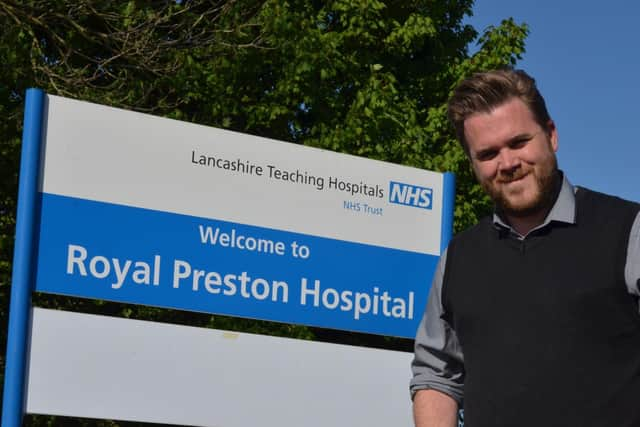'NHS in Preston and elsewhere is coming apart': city councillor's warning over waiting times
and live on Freeview channel 276
John Potter, Liberal Democrat group leader on Preston City Council, was speaking after figures revealed that almost 1,800 patients last month waited more than four hours to be admitted to the Royal Preston and Chorley and South Ribble hospitals after a decision had been made to do so. For 153 people who attended the facilities in December, the wait was over 12 hours.
More than 17,200 patients sought help from A&E facilities run by Lancashire Teaching Hospitals NHS Foundation Trust (LTH) in the final month of last year. Just under three quarters of them – 73.5 percent – were either treated and discharged or admitted within the four-hour target time, significantly above the England average of 65 percent.
Advertisement
Hide AdAdvertisement
Hide AdHowever, the national standard of 95 percent of patients being seen within that timeframe has not been met at an England-wide level in almost a decade.


Ambulance response times were also way off target last month – with “category 2” calls for urgent conditions being attended to in an average of 1 hour 12 minutes across the North West, when the target for such contacts – which include heart attacks and strokes – is 18 minutes.
Nationally, the Liberal Democrats have demanded that the government releases in full the new money promised to help discharge patients from hospitals, as soon as possible. The £500m social care pot, announced in October, is being distributed in two tranches.
Areas received 40 percent of their allocated share of the Adult Social Care Discharge Fund back in December, but the remainder is due to be paid by the end of this month.
Advertisement
Hide AdAdvertisement
Hide AdHowever, Cllr John Potter said that “the government’s failure to tackle the crisis in our NHS is letting down people in Preston and Central Lancashire and putting patients’ lives at risk”.
“How much more evidence do ministers need? They either don’t care or just can’t grasp the scale of this problem. Unacceptable and heartbreaking delays mean the government is falling far short even on its own targets.
“Far too many people in Preston and Central Lancashire are having to wait far too long to get the treatment they need. In many cases, this is literally a matter of life or death. People in our area deserve far better.
“Our NHS isn’t just at breaking point – it’s splitting at its very seams. We need action from the Conservatives.
Advertisement
Hide AdAdvertisement
Hide Ad“Liberal Democrats are demanding the government release the money they promised to help discharge patients from hospitals – and launch a campaign to recruit the extra paramedics and ambulance staff we need,” Cllr Potter said.
The party has launched a five-point winter plan in response to what it calls the “ambulance crisis”. The proposed measures include an increase in hospital beds and better mental health support in order to reduce the number of ambulance callouts for mental health reasons.
The Lib Dems are also promoting a bill that would require localised – rather than regionalised – reports of ambulance response times to be published in order to ensure “hot spot” areas, with the longest waits, are identified.
They want 12-hour waits at A&E to be calculated from the moment a patient arrives at hospital rather than the point at which a ‘decision to admit’ is taken – as currently – “so that the true scale of the problem is clear for all to see”.
Advertisement
Hide AdAdvertisement
Hide AdThe government says that its plan for tackling the current NHS pressures – and those flowing from the pandemic – includes the prioritisation of health and social care in last year’s Autumn Statement, when it made “up to £14.1 billion available…over the next two years, on top of record funding to reduce waiting times improve urgent and emergency care and returning performance to pre-pandemic levels”.
The Department for Health and Social Care says that the NHS is to “set out detailed recovery plans for urgent and emergency care, including ambitions to improve category 2 ambulance response times to 30 minutes and improve A&E waiting times”.
“Attendance [at] hospital is higher than pre-pandemic levels. Attendances in December 2022 were 4.7 percent higher than December 2019, bringing the total attendances for the month to over 2.28 million.
“Overall bed occupancy is also higher than previous years, general and acute bed occupancy was 94.6 percent in the week ending 8th January, compared to 93.0 percent in the same period last year.
Advertisement
Hide AdAdvertisement
Hide Ad“[That week], there were on average 4,914 patients with confirmed seasonal influenza in general and acute beds across England, compared to just 46 this time last year.”
The department added: “Addressing handover delays is a key priority. NHS England is providing targeted support to some of the hospitals facing the greatest delays in the handover of ambulance patients into the care of hospitals, helping them to identify short and longer-term interventions to improve delays and get ambulances swiftly back out on the road.
“We’re also speeding up hospital discharge, backed by £500 million, to free up hospital beds, improving flow through hospitals and speeding up handovers and get ambulances back on the road faster.”
